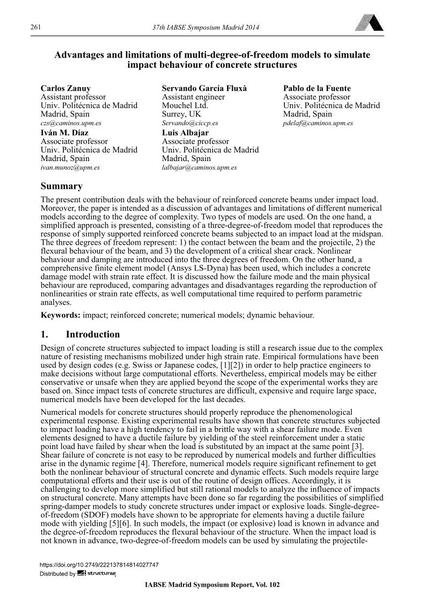Advantages and limitations of multi-degree-of-freedom models to simulate impact behaviour of concrete structures

|
|
|||||||||||
Bibliographic Details
| Author(s): |
Carlos Zanuy
Servando García Fluxà Pablo De La Fuente Iván M. Díaz Luis Albajar |
||||
|---|---|---|---|---|---|
| Medium: | conference paper | ||||
| Language(s): | English | ||||
| Conference: | IABSE Symposium: Engineering for Progress, Nature and People, Madrid, Spain, 3-5 September 2014 | ||||
| Published in: | IABSE Symposium Madrid 2014 | ||||
|
|||||
| Page(s): | 261-268 | ||||
| Total no. of pages: | 8 | ||||
| Year: | 2014 | ||||
| DOI: | 10.2749/222137814814027747 | ||||
| Abstract: |
The present contribution deals with the behaviour of reinforced concrete beams under impact load. Moreover, the paper is intended as a discussion of advantages and limitations of different numerical models according to the degree of complexity. Two types of models are used. On the one hand, a simplified approach is presented, consisting of a three-degree-of-freedom model that reproduces the response of simply supported reinforced concrete beams subjected to an impact load at the midspan. The three degrees of freedom represent: 1) the contact between the beam and the projectile, 2) the flexural behaviour of the beam, and 3) the development of a critical shear crack. Nonlinear behaviour and damping are introduced into the three degrees of freedom. On the other hand, a comprehensive finite element model (Ansys LS-Dyna) has been used, which includes a concrete damage model with strain rate effect. It is discussed how the failure mode and the main physical behaviour are reproduced, comparing advantages and disadvantages regarding the reproduction of nonlinearities or strain rate effects, as well computational time required to perform parametric analyses. |
||||
| Keywords: |
numerical models reinforced concrete dynamic behavior impact
|
||||
